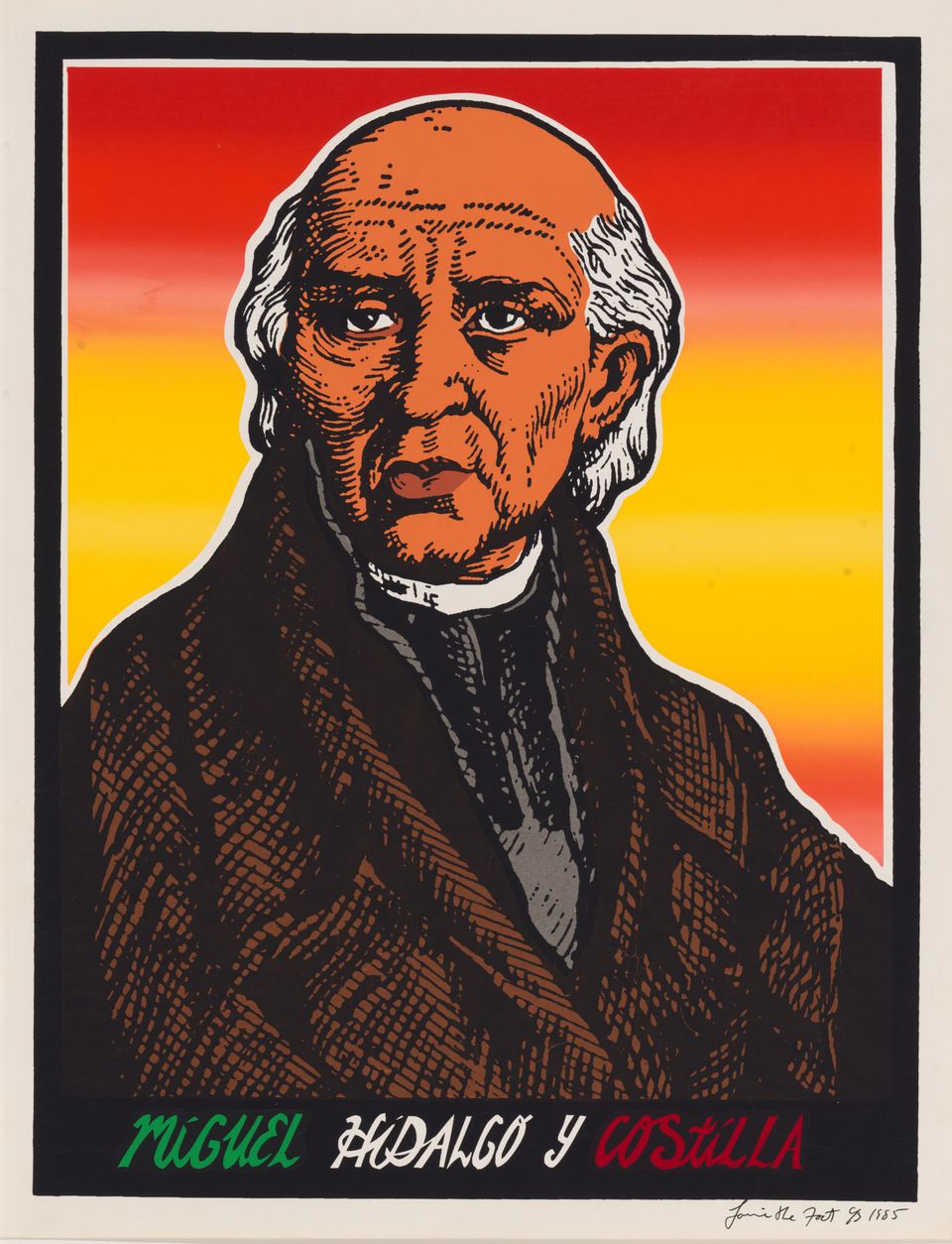The Print

Luis C. González, Miguel Hidalgo y Costílla, 1976, screenprint on paper, Smithsonian American Art Museum, Gift of Gilberto Cárdenas and Dolores García, 2019.51.51, © 1976, Luis C. González
Luis C. González
born Mexico City, Mexico 1953
Miguel Hidalgo y Costilla
1976
screenprint on paper
Gift of Gilberto Cárdenas and Dolores García, 2019.51.51
González produced Miguel Hidalgo y Costilla for a 16th of September celebration of Mexican independence. The artist renders Hidalgo’s name in the colors of the Mexican flag to further connect this independence fighter with the identity of the nation. This holiday was one of many Mexican-centered events that the Royal Chicano Air Force (RCAF) art collective promoted throughout Sacramento. They sold their prints at such events to support political causes and sustain community programming.
The Person

Library of Congress, Prints and Photographs Division, Caroline and Erwin Swann collection of caricature and cartoon, LC-DIG-ppmsc-04595
Miguel Hidalgo y Costilla
born 1753 – Penjamo, Viceroyalty of New Spain (today Guanajuato, Mexico)
died 1811 – Chihuahua, Viceroyalty of New Spain (today Chihuahua, Mexico)
“My Children, a new dispensation comes to us today. . . . Will you free yourselves?”
Catholic priest and revolutionary leader Miguel Hidalgo y Costilla is considered the father of Mexican independence. At a Mass in the small town of Dolores on September 16, 1810, he delivered his “El Grito de Dolores” (The Cry of Dolores), an impassioned call to rise against the Spanish government. It is perhaps the most famous speech in Mexican history. Both mestizo and Indigenous peoples answered the call and joined Hidalgo’s army to fight against the Spanish. Though Hidalgo was captured and executed in 1811, Mexico would achieve independence in 1821.
The Print

Luis C. González, Miguel Hidalgo y Costílla, 1976, screenprint on paper, Smithsonian American Art Museum, Gift of Gilberto Cárdenas and Dolores García, 2019.51.51, © 1976, Luis C. González
Luis C. González
born Mexico City, Mexico 1953
Miguel Hidalgo y Costilla
1976
screenprint on paper
Gift of Gilberto Cárdenas and Dolores García, 2019.51.51
González produced Miguel Hidalgo y Costilla for a 16th of September celebration of Mexican independence. The artist renders Hidalgo’s name in the colors of the Mexican flag to further connect this independence fighter with the identity of the nation. This holiday was one of many Mexican-centered events that the Royal Chicano Air Force (RCAF) art collective promoted throughout Sacramento. They sold their prints at such events to support political causes and sustain community programming.
The Person

Library of Congress, Prints and Photographs Division, Caroline and Erwin Swann collection of caricature and cartoon, LC-DIG-ppmsc-04595
Miguel Hidalgo y Costilla
born 1753 – Penjamo, Viceroyalty of New Spain (today Guanajuato, Mexico)
died 1811 – Chihuahua, Viceroyalty of New Spain (today Chihuahua, Mexico)
“My Children, a new dispensation comes to us today. . . . Will you free yourselves?”
Catholic priest and revolutionary leader Miguel Hidalgo y Costilla is considered the father of Mexican independence. At a Mass in the small town of Dolores on September 16, 1810, he delivered his “El Grito de Dolores” (The Cry of Dolores), an impassioned call to rise against the Spanish government. It is perhaps the most famous speech in Mexican history. Both mestizo and Indigenous peoples answered the call and joined Hidalgo’s army to fight against the Spanish. Though Hidalgo was captured and executed in 1811, Mexico would achieve independence in 1821.













